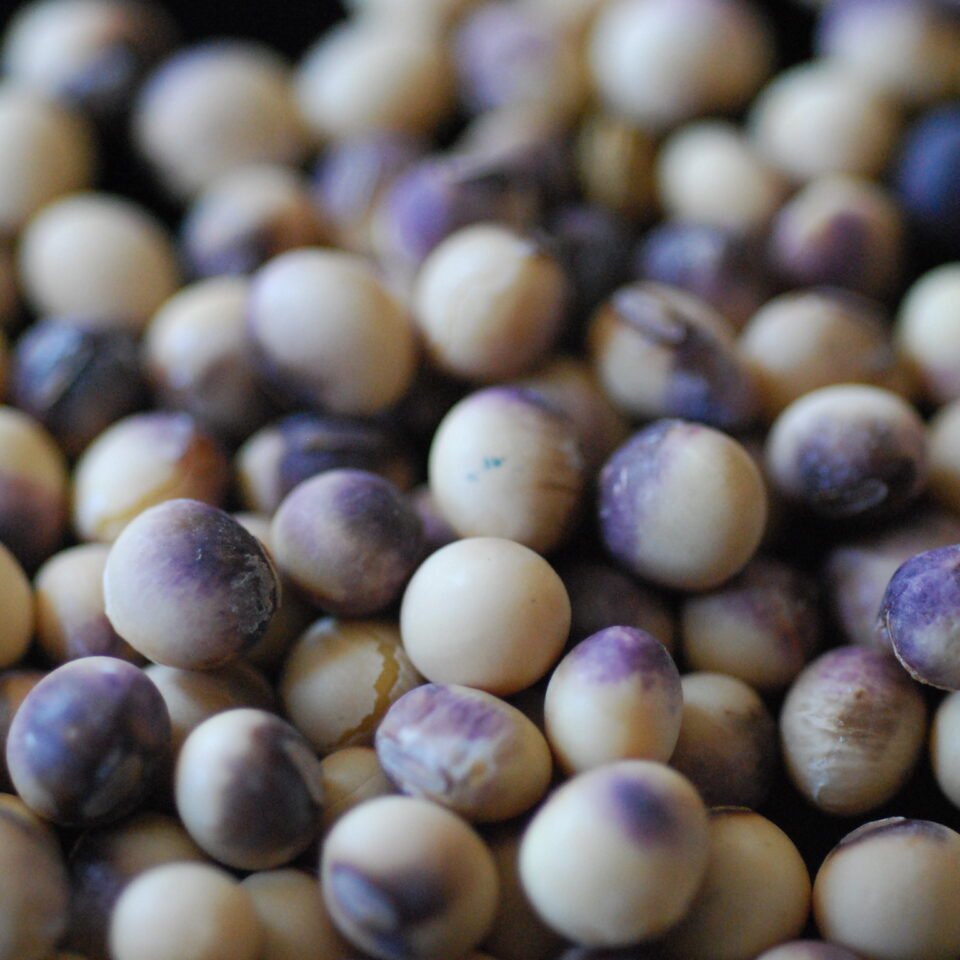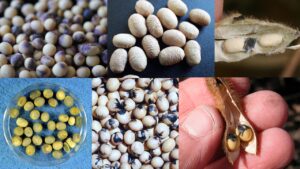
Identity Preserved (IP) soybeans are grown under contract, following set guidelines to ensure that the harvested crop meets the quality desired by the end user. The physical quality and appearance of the bean is important to meet the buyer’s demands for a healthy seed coat with no cracks, stains or dirt on the beans. There are many different things that could affect the quality of a bean, including weeds, disease, insects and weather.
Weeds
Weeds can pose a potential threat affecting quality. Other than yield loss, if they are present in the field at the time of harvest, they can stain the seed or cause the seed to become damp to which dirt may stick to, also known as mud-tagging. Another issue is some weed seeds are similar in size to the soybean, and are therefore difficult to separate out. There are four main weed species that you want to keep out of your field at all costs:
- Eastern Black Nightshade (stains seed)
- Pokeweed (stains seed)
- Giant Ragweed (large reduction in yield)
- Volunteer Corn (similar seed size to soybean)
With IP soybeans, weed control can be difficult at times with limited herbicide options (especially postemergent) available. Weed control in an IP program should be thought of as a multi-year prevention rather than trying to control weeds in the year of soybean production. This offers a wider range of herbicides that you are able to use in other rotational crops.
Disease
There are many diseases that can affect the quality and yield of an IP soybean. They cause quality issues through a number of methods including discolouration of the seed, fungal growth encrusting the seed, cracking of the seed coat, etc. While all diseases can affect yield, there are several that shown here that can have major effects on the quality of your IP soybean crop.
Cercospera Leaf Spot (Purple Seed Stain)
- ID: Purple discolouration or stain over part or all of the seed coat.
Management:
- Plant clean seed that is treated with fungicide.
- Crop rotation and removal of residue to reduce potential for infection.
- Plant a variety with greater tolerance.
Phomopsis Seed Mould
- ID: Fine cracks and mould starting near the hilum.
Management:
- Grow full season varieties that will harvest later, when conditions are less favourable for seed mould development.
- Plant later.
- Removal of crop residue.
White Mould
- ID: White fungal mould encrusting the seeds and pods, along with black sclerotia.
Management:
- Avoid growing host crops such as canola, edible beans, buckwheat and sunflowers.
- No-till following soybeans reduces the germination of the sclerotia.
- Grow varieties that are more tolerant to white mould and greater resistance to lodging.
Downy Mildew
- ID: Dull white appearance with a pale coating of fungal spores covering part or all of the seed.
Management:
- Removal of crop residue.
- Crop rotation with non-host crops such as corn and wheat.
- Fungicide seed treatment will help prevent seed-borne downy mildew.
Soybean Mosaic Virus
- ID: Brown or black discolouration and streaks near the hilum.
Management:
- Plant non-infected seed.
Bean Pod Mottle Virus
- ID: Smokey in colour with a brown or black mottling of the seed coat.
Management:
- Plant disease-free seed or resistant varieties.
- Control bean leaf beetle adults when populations are high early in the season.

Images (clockwise): Cercospera Leaf Spot, Phomopsis Seed Mould, White Mould, Bean Pod Mottle Virus, Soybean Mosaic Virus and Downy Mildew.
Image Sources: Crop Protection Network
Environmental Influences
Other factors that can influence the quality of the seed is environmental conditions during the growing season and at harvest. Since these issues are caused by weather, there is little you can do to help the problem. The best option is to select the best variety for the area and a good crop rotation.
Seed Coat Damage (Cracking)
- Cause: Dry moisture levels of the bean and low humidity at harvest.
- Management: Wait until the beans gain back some moisture. This could mean harvesting early in the morning when there is some dew to bring back to moisture into the beans.
Green Colouring
- Cause: An extremely dry growing season can cause the seed to stay green through to maturity. During a drought period, the seeds have minimal activity inside and are not able to break down the chlorophyll in the seed, causing it to stay green.
- Management: Weather related, only option is to select the best variety for the area and have a good crop rotation.
Growth Marks
- Cause: Seed coat does not entirely close.
- Management: Weather related, only option is to select the best variety for the area and have a good crop rotation.

Images (left to right): Seed coat damage, green colouring and growth marks.
Image Sources: Fontanelle, Integrated Pest Management at the University of Missouri, Channel Seed
Featured Image: Crop Protection Network